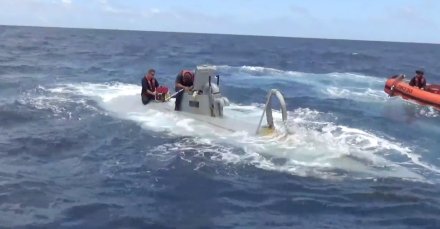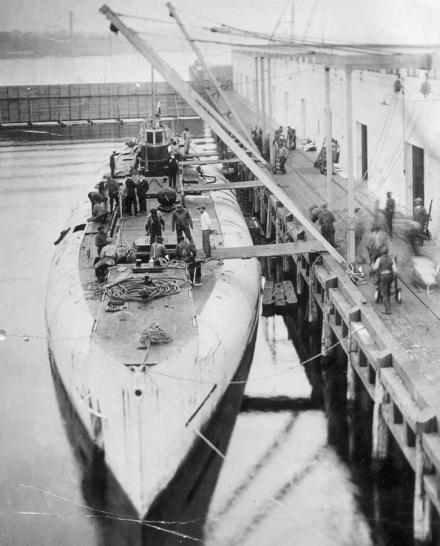If you think that ‘SPSS’ refers to the Statistical Package for the Social Sciences software tool, as used by so many of my students, think again. Today we’re in the domain of law enforcement, looking at Self-Propelled Semi-Submersibles.
Back in the 1980s, the preferred method for getting cocaine from Colombia to Mexico was to make a dash in a “cigarette boat” – a small, fast vessel that might otherwise be used for offshore powerboat racing. Similarly, during the era of prohibition, “rum runners” had used speed to evade the US Coast Guard.
That’s the way things were done, back when we were all watching ‘Miami Vice’ on TV, but running drugs by sea became a much more difficult proposition when radar coverage was improved and the Coast Guard were equipped with better boats of their own. (How unsporting!)
The drug smuggling business is a simple matter of economics: the cost of a kilo of cocaine when it leaves a jungle lab in South America is around $1,500 but it will have a street value of $50,000 or more when it reaches a major US city. Profits like that mean there is no shortage of people who are prepared to try their luck in the smuggling business, and they also allow a lot of scope for investment in the supply chain: hired muscle, firearms, bribes for officials… and narco-submarines.
Rumours that submarines were being constructed for the purposes of drug-running had been heard throughout the 1990s, but it was a long time before one was actually seen. Meanwhile, they acquired the nickname Bigfoot, after the legendary forest-dwelling cryptid: everybody’s heard of the beast, but few can claim to have seen one.
In November 1988 a submersible ‘capsule’ 6.4m in length was found off Boca Raton, Florida. It had been designed to be towed behind a boat, and could be submerged by remote control. When discovered it was empty: whatever it had contained had already been smuggled into the USA.
For a while, this was the only hard evidence to support the submersible drug-smuggling hypothesis. Then in 2000 a half-finished submarine was found in a warehouse in the suburbs of Bogotá, the Colombian capital. Documents in Russian were recovered from the site, suggesting a Russian mafia connection, or perhaps that Russian technicians had been involved in the construction project. This wasn’t the first such connection: in 1995 an émigré from the former Soviet Union had been arrested in Miami while trying to broker a deal between the Russian mafia and the Colombian cartels, concerning the sale of an old Soviet submarine.
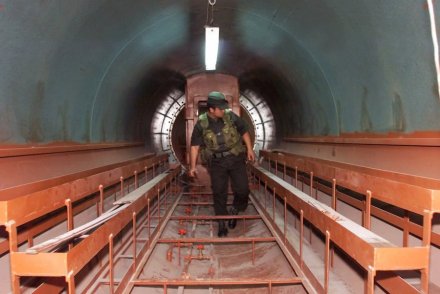
Inside the half-built submarine that was found in a warehouse in Bogotá. If completed it would have been able to transport over 180 tonnes of drugs, submerging to evade law enforcement.
News of the Bogotá find flashed around the world: Bigfoot had been found.
It wasn’t until 2006 that the US Coast Guard caught a Bigfoot at sea. A cutter encountered a strange vessel 145km southwest of Costa Rica. It was around fifteen metres in length, and featured three snorkels. On board they found four men, an AK-47… and 2.7 tonnes of cocaine.
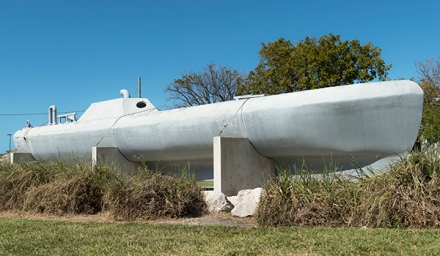
The first Bigfoot, seized in November 2006, is now on display at the Joint Interagency Task Force South. [Photo: Department of Defense / Petty Officer 2nd Class Dominique A. Pineiro]
This wasn’t a true submarine, but a semi-submersible: a simpler and more affordable craft that can reduce its buoyancy until there’s almost nothing visible above the waterline. Others, often lumped in with semi-submersibles are in fact low-profile vessels, but their purpose is the same and either type can be put together in the jungle without requiring the kind of materials or skills that will attract attention. (Building a true submarine in Bogotá had proved to be rather conspicuous, not least because the city is 2,640 metres above sea level, which wouldn’t have made for an easy launch!) Semi-submersibles are typically made from fibreglass and wood, so if you can build a motorboat you probably have the skills and tools necessary to make a simple smuggling craft of this kind. Dozens of the things are being built every year.
For all their homespun simplicity, semi-submersibles are a very potent threat. The materials from which they’re constructed make them hard to spot on radar, and additional sneakiness is achieved by painting them the same colour as the sea and having them ride so low in the water that there’s almost nothing to reveal their presence. Exhaust gases from the engines are sometimes routed through long pipes that run under the boat, such that seawater provides a cooling function: such vessels aren’t going to show up on infrared.

Most narco-subs are very basic, but the War on Drugs has forced the pace of technological advancement, as the interior of the vessel on the right shows. [photos: Luca Zanetti]
A key weapon in the good guys’ arsenal is the Drug Trafficking Vessel Interdiction Act, brought into US law in September 2008. This was the legislation that specifically named the Self-Propelled Semi-Submersible, and made it illegal to operate an unregistered one in international waters. Before that, any smuggler who got caught could simply scuttle their boat to turn a drugs bust into a ‘rescue operation’ from which no prosecution was possible as the evidence was lost. Nowadays, if you’re caught on board a Bigfoot, you go to jail for a very long time.
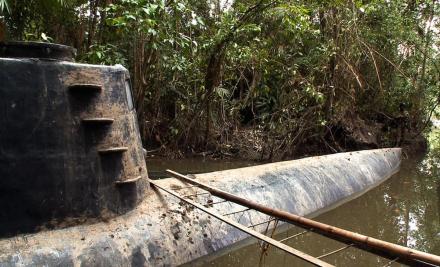
Some narco-subs are surprisingly sophisticated, such as this fully submersible example, seized in 2011.
Drug smuggling submarines have an interesting ancestor in the merchant submarine. In the First World War the Germans built two of these for the purpose of conducting trade with the USA – something that had become all but impossible due to an allied naval blockade. Deutschland and Bremen were developed and constructed using private funds, and launched in 1916. Deutschland made a highly successful trip to the USA, arriving in July 1916 with something like 680 tonnes of cargo on board. Chemical dyes, medicines, gemstones and mail were delivered, and then the submarine returned to Bremerhaven with a cargo of nickel, tin and rubber – vital war materials. As would be seen with Bigfoot ninety years later, the profit from a single voyage more than justified the cost of construction. Bremen set out for the USA on a similar trading mission in August 1916, and was never seen again. One theory is that she hit a mine, while another suggests a collision. Nobody knows.
Deutschland made a second successful trip in November 1916, and would have been sent out again but relations with the USA had soured and trade became impossible. In April 1917 the Americans entered the war on the allied side, bringing an end to the usefulness of the merchant submarine. Deutschland and others of the same type still under construction were converted to long-range ‘submarine cruisers’ and sent out to fight – with considerable success.
New merchant submarine applications have been proposed from time to time, although none has left the drawing board. In the USA, General Dynamics explored the possibility of submarine tankers for oil and liquefied natural gas, opening up arctic oilfields to wider exploitation. The Soviet Union also had plans to build submarine tankers and even a 912 TEU container boat, configured for trading routes beneath the polar ice cap… but the Soviet Union collapsed instead, leaving futuristic submarine cargo vessels as something that you’re only going to see on Thunderbirds for a while yet.
Update: narcosubs have now gone transatlantic, with the Spanish capturing one in November 2019 for the first time. It is said to have travelled 7,700 kilometers (4,800 miles) and contained cocaine worth $121 million.
This is part of an occasional series of articles on strange modes of transportation. If you enjoyed this one, why not have a look at the transporter bridge, missile mail, the sea-going tram, aircraft with swappable passenger pods, or the gyro-monorail?

